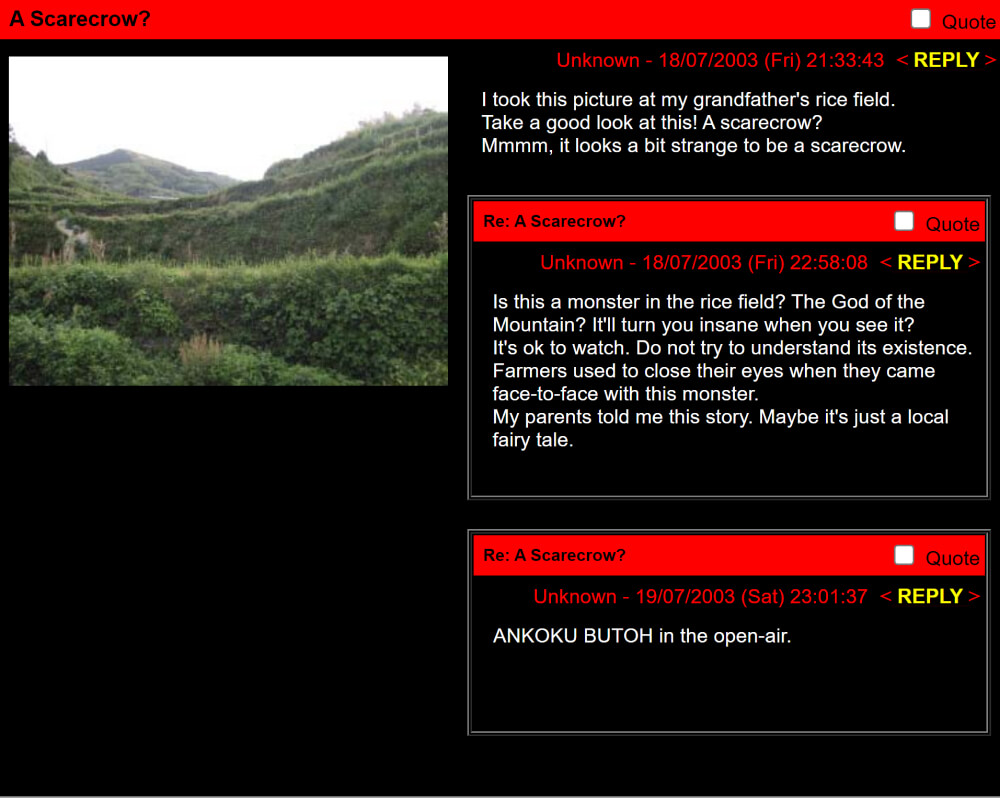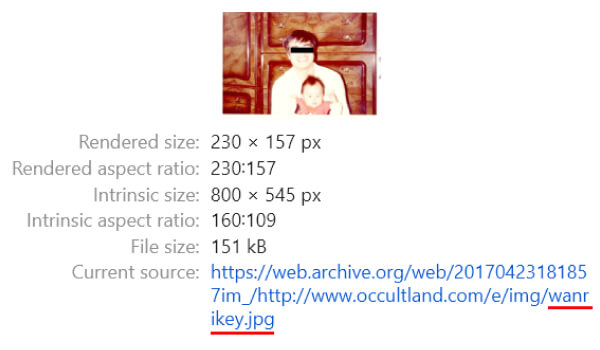What is “Occult Land”?
If you’re a fan of Forbidden SIREN, you probably know that ‘Occult Land’ is an occult-themed forum on the internet in the world of SIREN.
The protagonist of the game, Kyoya Suda, decided to go to Hanuda Village after becoming interested in posts about the “×× Village 33-Person Massacre” written on this forum.
Kyoya himself also made posts on this forum under the handle name SDK, mentioning that he was in summer vacation and expressing his intention to actually visit the village.
At the time, this site was actually created by Sony Interactive Entertainment and, while you couldn’t make posts, it was made to look like a real forum. Although it was accessible via the link http://www.occultland.com/ until a few years ago, the site has since gone.
The banner at the top features Naoko Mihama. The design differs between the Japanese and English versions.
(The Japanese banner says “Heart is ♥♥♥ Doki Doki (thump-thump) Get beautiful♪”)
Recently, I wrote about the promotional website for SIREN, which is also already gone, and covered Naoko Mihama, Harumi Yomoda, Akira Shimura, and Kyoya Suda featured on the site. During that time, I was able to view the backup site of Occult Land, and it was quite interesting, so I would like to explore the site a little more today.
Occult Land Forum – the Earlier Posts
On the Occult Land forum, the first page is filled with posts regarding the “XX Village 33-Person Massacre,” a post from Kyoya (aka SDK), and replies from other users worrying about him.
These posts are from late July to August 2003, but clicking on the second page of the board reveals earlier posts.
The topics discussed on the second page are unrelated to Hanuda Village, and the content of the posts mainly revolves around occult stuff that was popular in Japan from the early to mid-2000s.
Looking at them now brings me a sense of nostalgia and reminds me of the good old days when supernatural things were still way more enjoyable than they are now. So, let’s explore from the second page before seeing the first page.
If you want to skip this section and read about the first page, please click here.
Scarecrow
The first thing I thought when I saw this post was that this story sounded like “kunekune.” (If you are not Japanese and know what ‘KuneKune’ is, you are a hardcore Japanese horror fan.)
“Kunekune” is one of the ghost stories that has spread on the internet since around 2003. The term “kunekune” is an onomatopoeic expression in Japanese used to describe a twisting or winding movement. It refers to a mysterious entity, appearing as a white or black figure moving in a twisting motion, often seen across rice fields or rivers far away. It is believed that witnessing this presence and uncovering its true nature leads to severe mental disturbance.
I looked at the image information on the website on a whim and noticed that its file name was actually ‘kunekune,’ lol.
I then briefly thought this post might be the origin of the ‘Kunekune’ story. However, it appears the original story dates back to 2000, posted on some ghost story site. So, this one cannot be the original as this site was created after 2003.
Regardless, it’s likely that the staff who created this website also enjoyed internet horror stories and urban legends like ‘Kunekune’.
Macho Man
This photo is about how the pattern on the back of the chest of drawers looks like some sort of muscular character.
When I looked at the image information again, I found that it said “wanrikey.jpg” lol.
(“Wanrikey” is the Japanese name of Machop, a Pokémon,)
As I mentioned in a previous article, “horror” and “technology” just don’t mix well at all. Nowadays, with smartphones equipped with ultra-high-resolution cameras so common, those ghostly photos have completely disappeared.
Back when smartphones didn’t have cameras and digital cameras were not mainstream, you had to wait until the photos were developed to actually see them. That moment of looking at the developed photo and noticing something eerie captured in it was the essence of ghost photography.
Also, because the resolution was poor, blurry images, shadows, or flashes sometimes looked like human figures or something that was not supposed to be there.
There used to be plenty of TV shows about paranormal phenomena and ghost stuff back then too, but you hardly see them anymore… It’s sad as a horror fan.
Baby Rock
Regarding this, I’m not quite sure what the reference is.
Sky Fish
Do you remember skyfish? Isn’t it ridiculously nostalgic? 😂
Skyfish was often featured in paranormal TV shows and magazines. It included footage captured outdoors showing objects resembling semi-transparent fish, hence called skyfish, which gained popularity in the occult world.Ultimately, the true identity of skyfish turned out to be insects like flies flying in front of the camera. When insects fly into the camera lens, their movement can sometimes appear as an afterimage, creating an illusion of stick-like creatures moving at high speed.
This is yet another good example proving the poor compatibility between horror and technology, in my opinion. With today’s high-quality cameras, you won’t see skyfish anymore. (What a boring era we live in.)
It’s funny the second comment casually mentions Naoko having caught the skyfish in a TV show. Maybe skyfish does exist in the world of SIREN.
UFO
UFOs and extraterrestrial stuff were also quite popular back in the day. But even recently, the Mexican Congress held a public hearing on UFOs and unveiled two objects claimed to be ‘extraterrestrial life forms.’
It seems there is still plenty of room to enjoy this genre, unlike ghost photography.
What caught my eye in this photo, however, is Mount Fuji in the upper right corner. Seen from an airplane, the mountain must be beautiful.
2000s: The Golden Age of Occult Content
Looking back on all the posts on the second page, I found the horror from the era before YouTube and social media way more interesting.
Scary stories that emerged on the internet in the early to mid-2000s, such as “Kisaragi Station” or “Hitori Kakurenbo (One-Man Hide and Seek),” also featured a realistic storytelling style that made readers feel as though they could have taken place somewhere in Japan.
Starting from around 2010, people began exploring underground, taboo, or haunted locations and documenting their experiences on platforms like YouTube and social media. Ordinary people started sharing high-quality images and videos online, while Google Street View provided access to virtually any location in the world. Consequently, supernatural stories and occult places became more exposed, and the allure of tales like “secret rituals being held in Japan’s rural areas” totally diminished.
It’s getting lengthy so I better stop here:) Now, let’s go back to the first page where people, including SDK (Kyoya Suda), were discussing the massacre and the village.
(Unfortunately, the third page was not accessible, giving a Page Not Found error. I wonder if the other pages were all accessible back then.)
Occult Land Forum – “The ×× Village 33-Person Massacre” and SDK
This is the first post that eventually led Kyoya to visit the Hanuda Village.
(The illustration feels like it was made with Windows Paint, giving off a distinct early 2000s vibe.)
In the subsequent comments, someone brings up the urban legend of the “XX Village 33-Person Massacre,” and Kyoya, who is passionate about occult stuff, becomes excited about this story.
It’s worth noting that in the English version, Kyoya is portrayed as an 18-year-old student, but in the original Japanese version, he is still a 16-year-old high school student.
If a 16-year-old were to venture alone into such a remote mountain area on a motorcycle, I would definitely stop him if I were his parent…
However, according to “the laws of causality”, Kyoya was probably destined to come to this village. One could say that it was inevitable for Kyoya to go to the village. I’ve written more about this concept of causality (called “Ingaritsu” in Japanese) in the previous article, so if you’re interested, please take a look.
Subsequently, the ritual failed, and in the real world, the region was struck by a disaster of earthquakes and landslides, resulting in numerous missing persons.
Now, Kyoya Suda is officially being treated as one of the missing persons. Indeed, if there are no bodies, there’s no other option but to assume that.
Final Thoughts
I didn’t think this article was going to be this long! Back in the days when I loved SIREN, just like Kyoya, I was really into horror and occult stories, browsing the internet and reading various books. While reminiscing about those times, I wrote this article.
SIREN is still one of my favorite games, so I plan to continue writing articles about it from time to time. Please feel free to check them out if you’re interested.
Thank you for reading the article.





















Comments